Come Design with TI.We've got the right tools for you! |
|||||||||||||||||||||||||||||||||||||||||||||||||||
MCUJump to: MSP430F5529 USB | Tiva C Series | InstaSPIN™-FOC | MSP430 LaunchPad | Hercules RM42x | C2000 Piccolo
MSP430F5529 USB LaunchPad Evaluation Kit
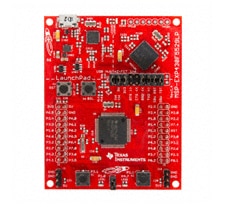
The MSP430 LaunchPad now has USB! The MSP-EXP430F5529LP LaunchPad (or the “F5529 LaunchPad”) is an inexpensive, simple evaluation module for the MSP430F5529 USB microcontroller. It’s an easy way to start developing on the MSP430, with an on-board emulation for programming and debugging, as well as buttons and LEDs for simple user interface. Rapid prototyping is a snap, thanks to 40-pin BoosterPack expansion headers, as well as a wide range of available BoosterPack plug-in modules. You can quickly add features like wireless, displays, sensors, and much more. You can either design your own BoosterPack, or choose among many already available from TI and elsewhere. The 40-pin interface is compatible with any 20-pin BoosterPack that is compliant with the standard. The MSP-EXP430F5529LP LaunchPad includes the MSP430F5529 16-bit MCU with 128KB Flash, 8KB RAM, up to 25MHz CPU speed, integrated USB 2.0 PHY, 12-bit analog-to-digital converter (ADC), timers, serial communication (UART, I2C, SPI) and more! Free and Open Source USB API stacks and the MSP430 USB Descriptor Tool, available through the MSP430 USB Developers Package allowing for quick configuration of USB applications.Free software development tools are also available, such as TI’s Eclipse-based Code Composer Studio and IAR Embedded Workbench. More information about the LaunchPad , the supported BoosterPacks and available resources can be found at TI’s LaunchPad portal and the MSP430 LaunchPad wiki for design resources and example projects.
More Information: TI Landing Page, User Guide, Quick Start Guide back to topTiva C Series TM4C1294 Connected LaunchPad
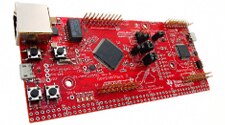
The Tiva™ C Series TM4C1294 Connected LaunchPad Evaluation Board is a low-cost evaluation platform for ARM® Cortex-M4-based microcontrollers. The Connected LaunchPad design highlights the TM4C1294NCPDT microcontroller with its on-chip 10/100 Ethernet MAC and PHY, USB 2.0, hibernation module, motion control pulse-width modulation and a multitude of simultaneous serial connectivity.
More Information: TI Landing Page, User Guide back to topInstaSPIN™-FOC enabled C2000 Piccolo LaunchPad
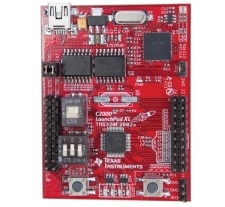
The InstaSPIN™-FOC enabled C2000™ Piccolo LaunchPad is an inexpensive evaluation platform designed to help you leap right into the world of sensorless motor control using the InstaSPIN-FOC solution. The LaunchPad is based on the Piccolo TMS320F28027F with unique features such as 64KB of on board flash, 8 PWM channels, eCAP, 12bit ADC, I2C, SPI, UART, and InstaSPIN-FOC in on-chip execute only ROM memory. The LaunchPad includes many board hardware features such as an integrated isolated XDS100v2 JTAG emulator for easy programming and debugging, 40 PCB pins for easy access to the pins of the F28027F processor, reset button and programmable button, etc. Works with various BoosterPacks.
More Information: TI Landing Page, User Guide, Quick Start, Manual back to topMSP430 LaunchPad Value Line Development kit
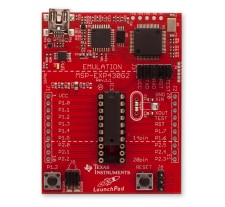
The MSP-EXP430G2 LaunchPad is an easy-to-use flash programmer and debugging tool for the MSP430G2xx Value Line microcontrollers. It features everything you need to start developing on an MSP430 microcontroller device. It has on-board emulation for programming and debugging and features a 14/20-pin DIP socket, on-board buttons and LEDs & BoosterPack-compatible pinouts that support a wide range of plug-in modules for added functionality such as wireless, displays & more. The MSP-EXP430G2 LaunchPad also comes with 2 MSP430 device, with up to 16kB Flash, 512B RAM, 16MHz CPU speed and integrated peripherals such as 8ch 10-bit ADC, timers, serial communication (UART, I2C & SPI) & more!
More Information: TI Landing Page, User Guide, Quick Start Guide back to topHercules RM42x LaunchPad Evaluation Kit
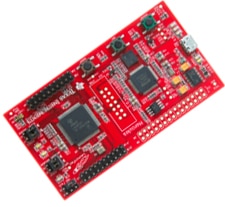
The Hercules RM42 LaunchPad is an inexpensive evaluation platform designed to help users evaluate and get started on development with Hercules microcontroller platform. The launchpad is based on Hercules RM42L432, which is a dual core lock-step ARM Cortex-R4 based MCU with features like 12-bit ADC, N2HET with programmable timer pins, eQEP, MibSPI and serial communication interfaces. The LaunchPad comes pre-programmed with Hercules Safety MCU Demo enabling users to easily learn about the key safety, data acquisition and control features of the Hercules MCU platform. The LauchPad features on-board emulation for programming and debugging, on-board buttons, LEDs and ambient light sensor & the standard 40 pin BoosterPack-compatible expansion header to support a wide range of plug-in modules for added functionality such as displays & more.
More Information: TI Landing Page, Quick Start Guide, Manual back to topC2000 Piccolo LaunchPad
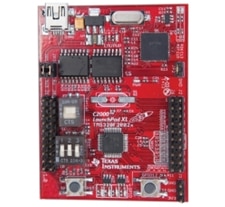
The C2000™ Piccolo LaunchPad is an inexpensive evaluation platform designed to help you leap right into the world of real-time control programming on the C2000 Piccolo microcontrollers. The LaunchPad is based on the Piccolo TMS320F28027 with unique features such as 64KB of on board flash, 8 PWM channels, eCAP, 12bit ADC, I2C, SPI, UART, and much more. It includes many board hardware features such as an integrated isolated XDS100 JTAG emulator for easy programming and debugging, 40 PCB pins for easy access to the pins of the F28027 processor, reset button and programmable button, etc. Not only does the C2000 LaunchPad have the required hardware for development, it is also provides users with access to example code, libraries, drivers, and many more resources through controlSUITE which is available for free. Along with controlSUITE, users can also download an unrestricted version of Code Composer Studio integrated development environment (IDE) version 5. With all the hardware and software needed to start development, users can focus on learning or developing real-time control systems in areas such as digital lighting, motor control, digital power conversion, precision sensing, and much more.
More Information: TI Landing Page back to topMPU/ArmJump to: BeagleBone Black | BeagleBone Development Board | xM Development Board | AM3359 | AM335x | OMAP-L138
BeagleBone Black Development Board
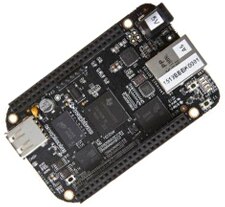
BeagleBone Black is a low-cost, open source, community-supported development platform for ARM® Cortex™-A8 processor developers and hobbyists. Boot Linux in under 10-seconds and get started on Sitara™ AM335x ARM Cortex-A8 processor development in less than 5 minutes with just a single USB cable. BeagleBone Black ships with the Debian GNU/Linux™ in onboard FLASH to start evaluation and development. Many other Linux distributions and operating systems are also supported on BeagleBone Black including:
BeagleBone Black's capabilities can be extended using plug-in boards called “capes” that can be plugged into BeagleBone Black's two 46-pin dual-row expansion headers. Capes are available for, VGA, LCD, motor control, prototyping, battery power and other functionality.
More Information: TI Landing Page, Quick Start Guide back to topBeagleBone Development Board
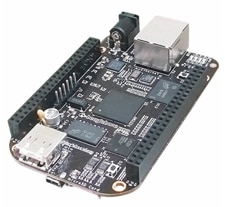
The BeagleBone is a low-cost, community-supported development platform for ARM® Cortex™-A8 processor developers. Boot Linux in under 10-seconds and get started on Sitara™ AM335x ARM Cortex-A8 processor development in less than 5 minutes with just a single USB cable. For TI-supported hardware platforms, consider the Sitara ARM AM335x Starter Kit or AM335x Evaluation Module. The BeagleBone ships with the Ångström Linux distribution on a micro-SD card to start evaluation and development. Many other Linux distributions and operating systems are also supported on BeagleBone including:
BeagleBone's capabilities can be extended using plug-in boards - called capes - that can be plugged into the BeagleBone's two 46-pin dual-row expansion headers. Capes are available for DVI-D, VGA, LCD, motor control, prototyping, battery power and other functionality.
More Information: TI Landing Page, Quick Start Guide, Manual back to topBeagleBoard-xM Development Board
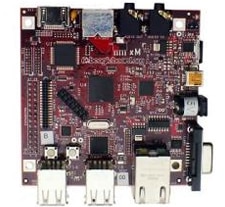
BeagleBoard-xM delivers extra MIPS with 1-GHz ARM® Cortex™-A8 performance from the Sitara™ ARM Cortex-A8 Processor and 512MB of low-power DDR RAM, enabling hobbyists, innovators and engineers to go beyond their current imagination and be inspired by the BeagleBoard.org community. Designed with the community’s inputs in mind, this open hardware design improves upon laptop-like performance and expandability, while staying at hand-held power levels. Direct connectivity is supported by the on-board four-port hub with 10/100 Ethernet, while maintaining a tiny 3.25” × 3.25” footprint. The BeagleBoard-xM has broad open-source software support options, including community supported Ångström Linux distribution, Ubuntu or several other Linux distros. It also supports the TI Android DevKit and TI Sitara Linux EZ SDK::TI-supported operating systems that will get you up and running with easy set-up and a quick out-of-box experience. They include a GUI for launching demos, benchmarks and applications. Plus, you can quickly get started on development of your own application. Windows Embedded Compact 7 is also supported via Adeneo embedded. The BeagleBoard-xM is a community-supported platform which can be the basis for building more complete systems, and as a target for community software baselines. As an alternative, the AM37x Evaluation Module (TMDSEVM3730) is directly supported by Texas Instruments.
More Information: TI Landing Page, Product Details, Manual back to topAM3359 Industrial Communications Engine
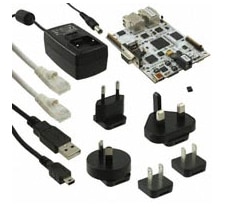
The AM3359 Industrial Communications Engine (ICE) is a development platform targeted for systems that specifically focus on the industrial communications capabilities of the Sitara AM335x ARM® Cortex™-A8 Processors. The AM335x ARM Cortex-A8 Processors integrate the Programmable Real-time Unit (PRU) that has been architected to implement the real-time communication technologies used in a broad range of industrial automation equipment. It enables low foot print designs with minimal external components and with best in class low power performance. TMDSICE3359 is a revised version of TMDXICE3359 with production AM3359 silicon and a notable improvements including:
More Information: TI Landing Page, User Guide back to topAM335x Starter Kit
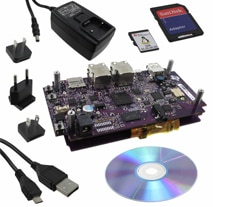
The AM335x Starter Kit (EVM-SK) provides a stable and affordable platform to quickly start evaluation of Sitara™ ARM® Cortex™-A8 AM335x Processors (AM3352, AM3354, AM3356, AM3358) and accelerate development for smart appliance, industrial and networking applications. It is a low-cost development platform based on the ARM Cortex-A8 processor that is integrated with options such as Dual Gigabit Ethernet, DDR3 and LCD touch screen. At speeds up to 720 MHZ, the AM335x Starter Kit accelerates designs with a ready-for-production hardware and software platform. This "best value" board offers the ability to quickly evaluate the features of the processor and accompanying TI components, taking the guess work out of the hardware design and allowing both experienced and novice designers to focus on product differentiation such as advanced graphics and connectivity.
More Information: TI Landing Page, User Guide back to topOMAP-L138 Development Kit (LCDK)
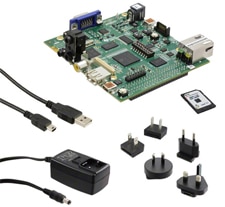
The OMAP-L138 DSP+ARM9™ development kit will enable fast and easy Linux software and hardware development. This scalable platform will ease and accelerate software and hardware development of everyday applications that require real-time signal processing and control functional, including industrial control, medical diagnostics and communications. The low-cost kit, complete with freely downloadable and duplicable board schematics and design files, greatly reduces design work. A wide variety of standard interfaces for connectivity and storage allow developers to easily bring audio, video and other signals onto the board. Expansion headers such as LCD screen expansion headers and Leopard Imaging’s camera sensor allow customers to extend the board’s functionality. The LCDK does not have an onboard emulator. An external emulator from TI (such as the XDS100, XDS200, XDS510, XDS560) or a third-party will be required to start development.
More Information: TI Landing Page back to topRF/WirelessJump to: CC2541 | CC3000 EVM | CC3000 BoosterPack | CC1120| CC11xLDK-868-915 | CC1200
CC2541 SensorTag Development Kit
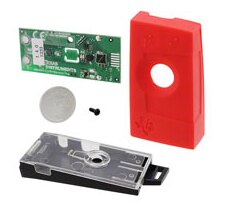
The CC2541 SensorTag is the first Bluetooth Smart development kit focused on wireless sensor applications and it is the only development kit targeted for smart phone app developers. The SensorTag can be used as reference design and development platform for a variety of smart phone accessories. TI is making Bluetooth low energy app development easier and faster with the CC2541 based SensorTag, which has all the commonly used sensors on a single board for quick evaluation and demonstration. The SensorTag works with TI’s TPS62730 (step down converter), and includes TI’s TMP006 IR MEMS temperature sensor, humidity sensor, pressure sensor, accelerometer, gyroscope and magnetometer. The versatility of the SensorTag means limitless app possibilities including those for health and fitness, medical, educational tools, toys, remote controls, mobile phone accessories, proximity and indoor locationing. The CC2541 SensorTag kit shortens the design time for Bluetooth low energy app development from months to hours with no embedded software design knowledge required. The SensorTag is preprogrammed with the FW needed to get started with smart phone app development and TI has a SensorTag App on the App Store providing developers easy access to the tools and software examples they need.
More Information: TI Landing Page, Quick Start Guide back to topCC3000 Evaluation Module
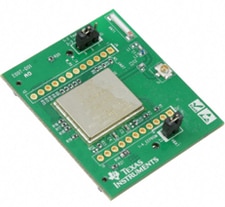
The CC3000 is a self-contained wireless network processor that simplifies the process of implementing Internet connectivity. SimpleLink™ Wi-Fi minimizes host microcontroller (MCU) software requirements making it the ideal solution for embedded applications using any low-cost and low-power MCU. The CC3000 Evaluation Module (EM) board is provided to aid evaluation and development. The EM board contains the CC3000 module, and standard RF1 and RF2 headers to connect to many TI platforms including MSP430, Stellaris, and C5000. Additionally, this complete platform solution includes software drivers, sample applications, API guide, user documentation and a world-class support community.
More Information: TI Landing Page, User's Guide back to topCC3000 BoosterPack
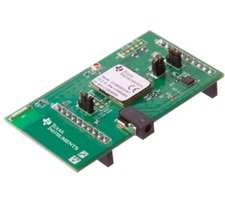
The CC3000 BoosterPack showcases the SimpleLink™ Wi-Fi CC3000 module, a self-contained wireless network processor that simplifies the process of implementing Internet connectivity. SimpleLink Wi-Fi minimizes host microcontroller (MCU) software requirements making it the ideal solution for embedded applications using any low-cost and low-power MCU. This BoosterPack aids in the evaluation and development of CC3000 solutions and contains the CC3000 module, power supply, and standard BoosterPack headers to connect to MSP430™, Tiva™ C Series, and future TI MCU LaunchPad evaluations kits. Additionally, this complete platform solution includes software drivers, sample applications, API guide, user documentation and a world-class support community.
More Information: TI Landing Page, User's Guide back to topCC1120 Performance Line Development Kit
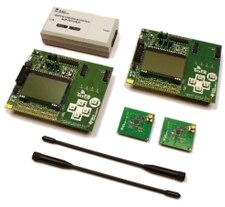
The CC1120 development kit provides a complete hardware performance testing and software development platform for TI's Sub-1 GHz Performance Line devices. The development kit comes with a pre-programmed packet error rate test. RF range and robustness can be tested with different RF settings, and power consumption can be measured easily. This kit supports 868MHz and 915MHz. Additionald Evaluation Module Kits can be purchased separately to support other frequencies. The kit includes the SmartRF Transceiver Evaluation board (TrxEB), which has a number of useful features for development of prototype software, as well as USB connectivity making it possible to connect the board to a PC and control the radio from SmartRF Studio. In short, the TrxEB includes
More Information: TI Landing Page, User's Guide back to topValue Line Development Kit 868-915MHz
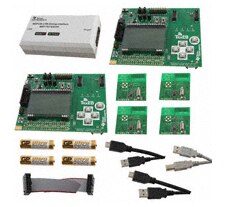
The CC11xLDK-868-915 development kit provides a complete hardware performance testing and software development platform for TI's Sub-1 GHz Value Line. The development kit comes with a pre-programmed packet error rate test. RF range and robustness can be tested with different RF settings, and powerconsumption can be measured easily. This kit supports 868MHz and 915MHz. An extra Evaluation Module Kit (CC11XLEMK-433) is needed to evaluate 433MHz. The TrxEB, Transceiver Evaluation Board, contains an MSP430 and the following peripherals for prototyping applications:
Example code for using these peripherals is part of the software examples. For application development, SmartRF Studio is used to generate RF settings and IAR or CCS can be used for programming the MSP430F548.
More Information: TI Landing Page, User's Guide back to topCC1200 Development Kit
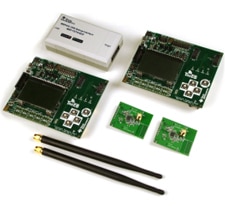
The CC1200 development kit provides a complete platform for hardware performance testing and software development for TI's sub-1 GHz CC1200 device. The development kit comes pre-programmed with a packet error rate test for easy out-of-the-box evaluation of the RF performance of the device. RF range and robustness can be tested with different RF settings, and power consumption can be measured easily. This kit supports the frequency range from 868 to 930 MHz. Additional plug-in boards (EMK) can be purchased separately to support other frequencies. The kit includes the SmartRF Transceiver Evaluation Board (TrxEB), which has a number of useful features for development of prototype software, as well as USB connectivity making it possible to connect the board to a PC and control the radio from SmartRF Studio.
More Information: TI Landing Page, Quick Start Guide, User's Guide back to topPowerJump to: TPS54560 | 30A SIMPLE SWITCHER® | 10A SIMPLE SWITCHER® | 2.5A SIMPLE SWITCHER® | TPS54160 | BQ27421EVM-G1A | bq27742-G1
TPS54560 Step-Down DC-DC Converter Evaluation Module
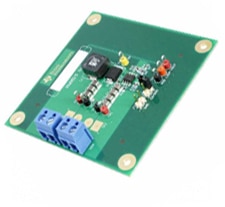
The Texas Instruments TPS54560EVM-515 evaluation module (EVM) is a fully assembled and tested circuit for evaluating the TPS54560 Step-Down DC/DC Converter. The EVM operates from a 7V to 60V input (12V nominal) and provides a 5.0V output at 5A. Key Features
More Information: TI Landing Page, User's Guide back to top30A SIMPLE SWITCHER® Power Module Evaluation Board, 3V to 14.5V Input
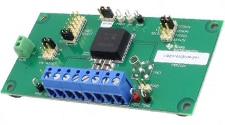
LMZ31530EVM-002 features a SIMPLE SWITCHER® power module which is an easy-to-use integrated power solution that combines a 30-A DC/DC converter with power MOSFETs, a shielded inductor, and passives into a low profile, QFN package. The EVM provides the user with convenient test points and connectors for full evaluation of the LMZ31530 device. Key Features
More Information: TI Landing Page, User's Guide back to topSIMPLE SWITCHER® 10A Power Module Evaluation Board
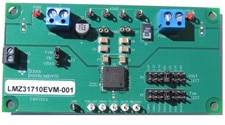
The Texas Instruments LMZ31710EVM-001 evaluation module (EVM) is a fully assembled and tested circuit for evaluating the LMZ31710 10A SIMPLE SWITCHER® Power Module. The EVM operates with an input voltage range of 2.95V to 17V. The output voltage can be selected from seven preset values using a jumper (0.6V, 0.9V, 1.2V, 1.8V, 2.5V, 3.3V, 5.0V). Key Features
More Information: TI Landing Page, Quick Start Guide back to topSIMPLE SWITCHER® 2.5A Power Module Evaluation Board
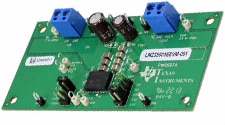
The Texas Instruments LMZ35003EVM-001 evaluation module (EVM) helps designers evaluate the performance and operation of the 2.5A SIMPLE SWITCHER® Power Module with 7V-50V Input. he EVM operates with an input voltage range of 7V to 50V with up to 2.5A capability. The output voltage can be selected from four preset values using a jumper (2.5V, 3.3V, 5V, 12V, 15V). The switching frequency can also be adjusted with jumpers (400 kHz, 500 kHz, 800 kHz, 1 MHz). 100V rated capacitors are placed on the input allowing the module to survive 65V line transients. Solder pads and jumpers are available to configure the EVM to specific requirements. Key Features
More Information: TI Landing Page, Quick Start Guide back to topTPS54160 42V Input, 5V Output, 1.5A Evaluation Module
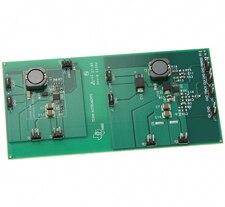
The TPS54160EVM-230 evaluation module (EVM) helps designers evaluate the operation and performance of the TPS54160 DC/DC converter. This converter is a wide input voltage (3.5 - 60V), 2.5MHz, non-synchronous, externally compensated, step down converter capable of 1.5A of output current. The TPS54160EVM-230 provides two independent DC/DC converters based on the TPS54160. The converter at the top of the board (top converter) is designed to operate from a nominal 42VDC ±25% input voltage source. This input voltage range is typical for input supplies derived from rectified 24VAC sources. The top converter provides a 5.0V output and up to 1.5A of output current. The top converter highlights a small solution size by using 0402 components with the minimum number of parts needed to provide a fully functional DC/DC converter complete with a programmed enable/disable voltage and soft start features. The converter at the bottom of the board (bottom converter) is designed to operate from 6.0V to 60V, the maximum recommended input voltage the TPS54160. The bottom converter provides a 3.3V output with up to 1.5A of output current. The bottom converter has additional component footprints that can be used by the designer to implement a variety of TPS54160 solutions. More Information: TI Landing Page, User's Guide, Datesheet back to topBQ27421EVM-G1A System-Side Battery Fuel (Gas) Gauge Evaluation Module Board
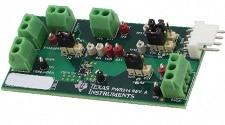
System-Side Battery Fuel (Gas) Gauge Solution Evaluation ModuleThe BQ27421EVM-G1A evaluation module is a complete evaluation system for the bq27421. The EVM includes one bq27421 circuit module with an integrated current-sense resistor. A separated orderable EV2300 or EV2400 PC interface board for gas gauge interface along with a PC USB cable, and Windows™-based PC software is needed when using this EVM. The circuit module includes one bq27421 integrated circuit and all other onboard components necessary to monitor and predict capacity for a system-side fuel gauge solution. The circuit module connects directly across the battery pack. With the EV2300 or EV2400 interface board and software, the user can: (1)Read the bq27421 data registers. (2)Program the chipset for different configurations. (3)Log cycling data for further evaluation. (4)Evaluate the overall functionality of the bq27421 solution under different charge and discharge conditions. The latest Windows™ – based PC software can be downloaded from the product folder on the Texas Instruments Web site.
More Information: TI Landing Page, User's Guide back to topBQ27742-G1 Single Cell Li-ion Battery Fuel (Gas) Gauge Programmable Evaluation Module
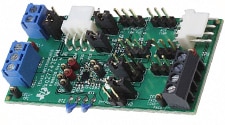
The BQ27742EVM along with Battery Management Studio software provide the customer with tools for developing a battery fuel gauge module for placement inside a lithium-based battery pack. Customers are able to configure the BQ27742EVM so that it can provide accurate battery fuel gauging information. The integrated protection functionality can also be evaluated with this EVM. BQ27742EVM gives the customer information such as battery voltage, temperature measurement, and Remaining State of Charge through its RAM registers. The BQ27742EVM allows the customer to evaluate the BQ27742 IC according to datasheet.
More Information: TI Landing Page, User's Guide, Manual back to topData ConvertersJump to: Serial Interface SAR ADC | ADS8861 | ADS1118 | DAC8760EVM | DAC3164
Performance Development Kit for 18-Bit, 1-MSPS, Serial Interface SAR ADC
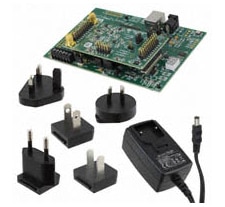
The ADS8881EVM-PDK is designed to evaluate the ADS8881 analog-to-digital converter (ADC). The converter is an 18 bit fully differential unipolar Successive-Approximation-Register (SAR) ADC with a maximum throughput of 1MSPS. The EVM includes input and reference drivers enabling the ADC to work within its typical performance specifications. It is designed around a 5V analog supply, which powers an on-board 4.5V reference. A fully differential driver buffers the inputs of the EVM making it possible to also convert bipolar signals. The EVM gives access to every digital pin of the converter making it easy to connect to any host microprocessor or TI DSP based system. Key Features
More Information: TI Landing Page, User's Guide, Datasheet back to topADS8861 Performance Demonstration Kit
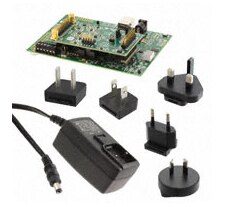
The ADS8861EVM-PDK is designed to evaluate the ADS8861 analog-to-digital converter (ADC). The converter is a 16 bit fully differential unipolar Successive-Approximation-Register (SAR) ADC with a maximum throughput of 1MSPS. The EVM includes input and reference drivers enabling the ADC to work within its typical performance specifications. It is designed around a 5V analog supply, which powers an on-board 4.5V reference. A fully differential driver buffers the inputs of the EVM making it possible to also convert bipolar signals. The EVM gives access to every digital pin of the converter making it easy to connect to any host microprocessor or TI DSP based system More Information: TI Landing Page, Datasheet, User's Guide back to topADS1118 BoosterPack
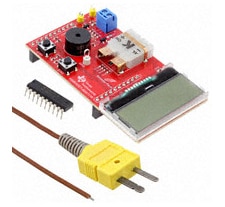
The 430BOOST-ADS1118 Booster Pack provides a quick and low-cost solution to evaluate and develop the ADS1118 for temperature measurement applications using type K thermocouples. This booster pack comes with preloaded firmware for the MSP430G2553 device. The software also provides fully commented source code for users to get started developing applications. Key Features
What's Included
More Information: TI Landing Page, Datasheet, User's Guide back to topDAC8760EVM - Evaluation Module for 16-Bit, Programmable Current/Voltage Output DAC
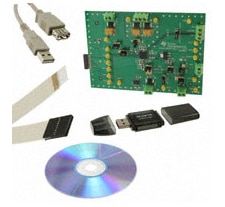
The DAC8760EVM (evaluation module) provides an easy to use platform for evaluation of the performance and operating characteristics of the DAC8760 (16-bit, Voltage Output & Current Output DAC). The EVM is a complete evaluation kit that includes a USB-based motherboard called the SM-USB-DIG, USB cable, and evaluation software for use with a personal computer equipped with Microsoft™ Windows XP and Windows 7 operating systems. Key Features
More Information: TI Landing Page, User's Guide back to topDAC3164 Evaluation Module
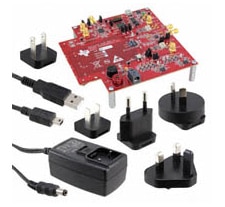
The DAC3164EVM is a circuit board that allows designers to evaluate the performance of Texas Instruments' dual-channel 12-bit 500 MSPS DAC3164 digital-to-analog converter (DAC). The EVM provides a flexible environment to test the DAC3164 under a variety of clock, and input conditions. For ease of use as a complete RF transmit solution the DAC3164EVM includes the CDCE62005 clock generator/jitter cleaner for clocking the DAC3164 as well as a TRF3705, a 400MHz to 4GHz quadrature modulator, for upconverting I/Q outputs from the DAC to real signals at RF. The EVM can be used along with TSW1400 to perform a wide range of test procedures. The TSW1400 generates the test patterns which are fed to the DAC3164 through a 1.00 GSPS LVDS port. The DAC3164EVM clock chip can be used to synchronize the TSW1400 board to DAC3164EVM. The TSW1406EVM provides a low-cost solution for quick EVM testing with up to 64k sample pattern depth. Key Features
More Information: TI Landing Page, User's Guide back to topAmplifiersJump to: THS4531ADGKEVM | OPA857 | INA300 | OPAMPEVM
THS4531ADGKEVM Evaluation Module
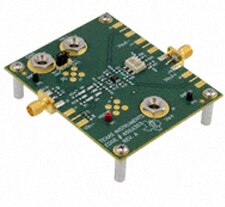
The THS4531ADGKEVM is designed to quickly and easily demonstrate the functionality and versatility of the amplifier. The EVM is ready to connect to power, signal source, and test instruments through the use of on-board connectors. The default amplifier configuration is single-ended input, single-ended output (via transformer), and split supply. It can be easily configured for differential input, differential output, and single supply operation. Key Features
More Information: TI Landing Page, User's Guide back to topOPA857 Evaluation Module
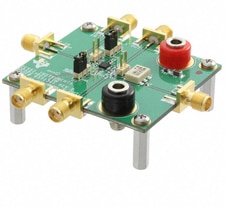
The OPA857EVM is an evaluation module for the OPA857 amplifier in a QFN-16 (RGT) package. This evaluation module is designed to quickly and easily demonstrate the functionality and versatility of the amplifier. The EVM is ready to connect to power, signal source, and test instruments through the use of onboard connectors. The EVM comes configured for easy connection with common 50-Ω laboratory equipment on its inputs and outputs. The amplifier is configured for a single-ended input with a selectable transimpedance gain (5kΩ/20kΩ). The pseudo-differential output at the device pins is then converted to a single-ended signal through an RF transformer. Key Features
More Information: TI Landing Page, User's Guide back to topINA300 High or Low Side, Bi-Directional Zerø-Drift Series Current Sense Comparator Evaulation Module
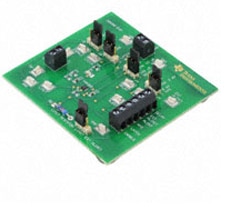
The INA300 is a high common-mode, precision, bidirectional, current-sensing comparator that can be configured to detect over current conditions through the voltage developed across a shunt resistor. Operating from a single power supply from 2.7 V to 5.5 V, the INA300 can be configured to detect shunt voltages from 0 V to 250 mV in the presence of common-mode voltages from 0 V to 36 V. The INA300EVM allows for easy user configuration of the INA300 device by using jumpers. Key Features
More Information: TI Landing Page, User's Guide back to topUniversal Operational Amplifier Evaluation Module
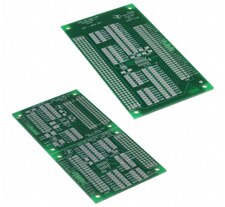
The Universal OPAMPEVM is a series of general purpose blank circuit boards that simplify prototyping circuits for a variety of IC package types. The evaluation module board design allows many different circuits to be constructed easily and quickly. Five models are offered with each targeted for specific package types: PDIP, SOIC, MSOP, TSSOP and SOT23 packages are all supported. See the chart below to assist in selecting the correct model. Note: These boards are unpopulated, so remember to order your op amp device samples. What's Included
More Information: TI Landing Page, User's Guide back to topInterfaceJump to: TLK110 | SN65HVD72EVM | DS90UB925Q | ISO5500
TLK110 Evaluation Module
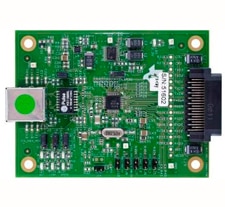
The TLK110CUSEVM provides a platform that allows the users to easily evaluate, design and market systems containing the TLK110 device. Key Features
More Information: TI Landing Page, User's Guide back to topSN65HVD72EVM Evaluation Module
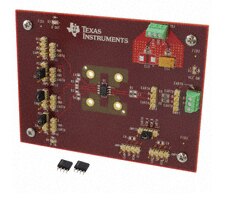
The SN65HVD72EVM helps designers evaluate the device performance, supporting fast development and analysis of data transmission systems using the SN65HVD72/SN65HVD75/SN65HVD78 transceivers. The EVM board comes with the SN65HVD75 (20Mbps) device soldered to the board. The EVM kit includes an IC sample pack with the SN65HVD72 (250kbps) and the SN65HVD78 (50Mbps) device. Either device can be evaluated by replacing the SN65HVD75 with the desired speed grade device. Key Features
More Information: TI Landing Page, Datasheet, User's Guide back to topDS90UB925Q Evaluation Module
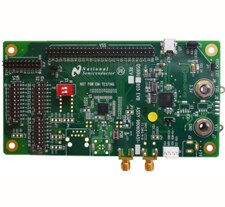
The DS90UB925QSEVB is an evaluation board designed to demonstrate the performance and unique features of the DS90UB925Q FPD-Link III serializer. The DS90UB925QSEVB board is designed to drive any of TI’s compatible FPD-Link III deserializer devices. The LVCMOS inputs of the DS90UB925Q are accessible via a parallel pin header interface. The FPD-Link III serial output interface is configured with SMA connectors. Jumpers and switches on the boards can be used to configure chipset features. An I2C interface and programming tool provides a method to configure and enable the advanced features of the serializer thru registers. Key Features
More Information: TI Landing Page, User's Guide back to topISO5500 Evaluation Module
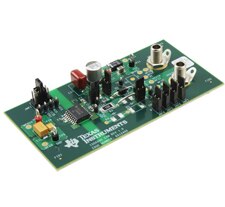
The ISO5500EVM can be used to evaluate device parameters while acting as a guide for board layout. The board allows the user to evaluate device performance using a simulated (10 nF) IGBT load installed on the board, or to install an IGBT or MOSFET (TO-247 package)onto the board and drive it with the ISO5500. Key Features
What's Included
More Information: TI Landing Page, User's Guide back to topAudio/TemperatureJump to: TMP006 | TLV320AIC3268EVM-U | ADS1118 | PCM3070RHBEVM-K | TPA3130D2
TMP006 Booster Pack
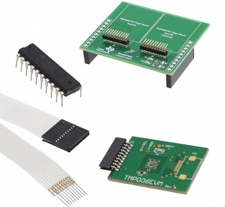
The TMP006 BoosterPack is a simple adapter board that allows the TMP006EVM circuit board to be used with the MSP430 LaunchPad. EVM is designed to allow full evaluation of the TMP006 device. The EVM features the TMP006 device with the required specific PCB layout and some simple support circuitry. The GUI for the EVM implements the full object temperature calculations allowing the user to measure object temperatures with the TMP006 BoosterPack. The TMP006 BoosterPack kit can connect to 2x TMP006EVM circuit boards at once. 1x TMP006EVM circuit board is included in the kit. Key Features
More Information: TI Landing Page, User's Guide back to topTLV320AIC3268EVM-U Ultra Low Power Audio Codec Evaluation Module
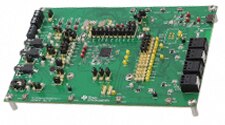
The TLV320AIC3268EVM-U is a complete evaluation/demonstration kit for the TLV320AIC3268 audio codec. The TLV320AIC3268EVM-U uses TI's PurePath™ Console GUI (PurePathConsole – must be requested separately). PurePath Console is an intuitive, easy-to-use, powerful tool to learn, evaluate, and control the TLV320AIC3268. With this EVM you have a complete audio evaluation system that allows audio inputs from a variety of sources to the TLV320AIC3268EVM-U, and a GUI to control the device and supporting circuitry. The TLV320AIC3268EVM-U is operational with one micro-USB cable connection to a PC. The USB connection provides power, control, and streaming audio data to the EVM for reduced setup and configuration.
More Information: TI Landing Page, Datasheet, User's Guide back to topADS1118 BoosterPack

The 430BOOST-ADS1118 Booster Pack provides a quick and low-cost solution to evaluate and develop the ADS1118 for temperature measurement applications using type K thermocouples. This booster pack comes with preloaded firmware for the MSP430G2553 device. The software also provides fully commented source code for users to get started developing applications. Key Features
What's Included
More Information: TI Landing Page, Datasheet, User's Guide back to topPCM3070RHBEVM-K Evaluation Module

The PCM3070EVM-K is a complete evaluation kit, which includes a universal serial bus (USB)-based motherboard and evaluation software for use with a personal computer running the Microsoft Windows™ operating system. The PCM3070EVM is in the Texas Instruments (TI) modular EVM form factor, which allows direct evaluation of the device performance and operating characteristics and eases software development and system prototyping. The PCM3070EVM-K is a complete evaluation/demonstration kit, which includes a USB-based motherboard called the USB-MODEVM Interface board and evaluation software for use with a PC running the Microsoft Windows operating systems. The PCM3070EVM-K is operational with one USB cable connection to a PC. The USB connection provides power, control, and streaming audio data to the EVM for reduced setup and configuration. The EVM also allows external control signals, audio data, and power for advanced operation, which allows prototyping and connection to the rest of the development or system.
More Information: TI Landing Page, Datasheet, User's Guide back to topTPA3130D2 Evaluation Module
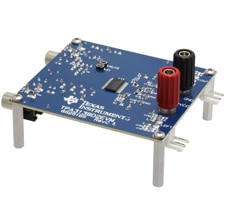
The TPA3130D2 evaluation module consists of a single 15-W, Class-D, stereo audio power amplifier complete with a small number of external components mounted on a circuit board that can be used to directly drive a speaker with an external analog audio source as the input. The EVM’s default output filter configuration supports LC filter operation, but can easily be configured to support filter-free operation. The EVM can also be configured as a 30-W, Class-D mono audio power amplifier. Designers can quickly evaluate the sound quality and verify specifications in their application with the TPA3130D2EVM. In addition, the TPA3130D2EVM User's Guide contains the schematic, layout and bill of materials for a reference design.
More Information: TI Landing Page, Datasheet, User's Guide back to top |
Texas Instruments Part SearchFeatured ProductsFeatured PTMs |
||||||||||||||||||||||||||||||||||||||||||||||||||













